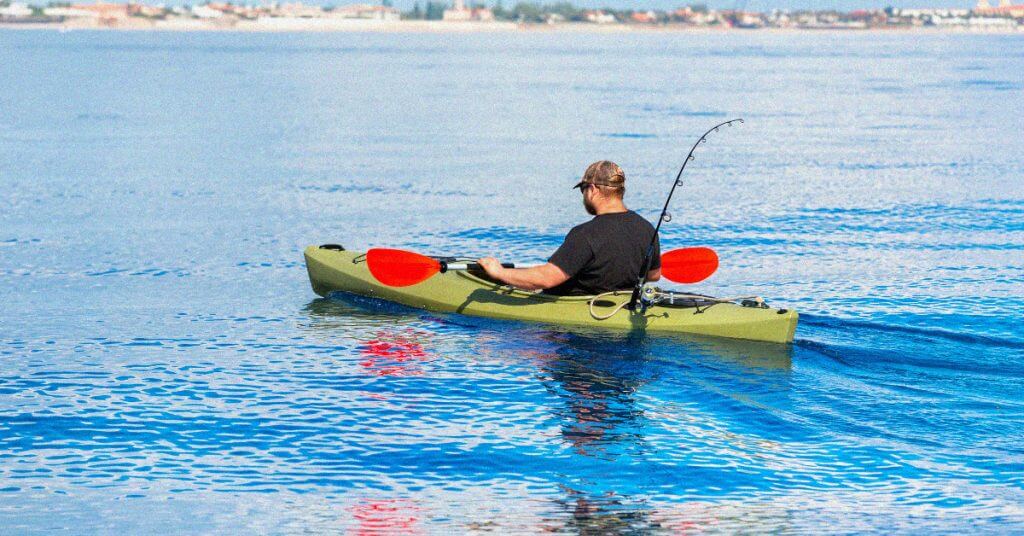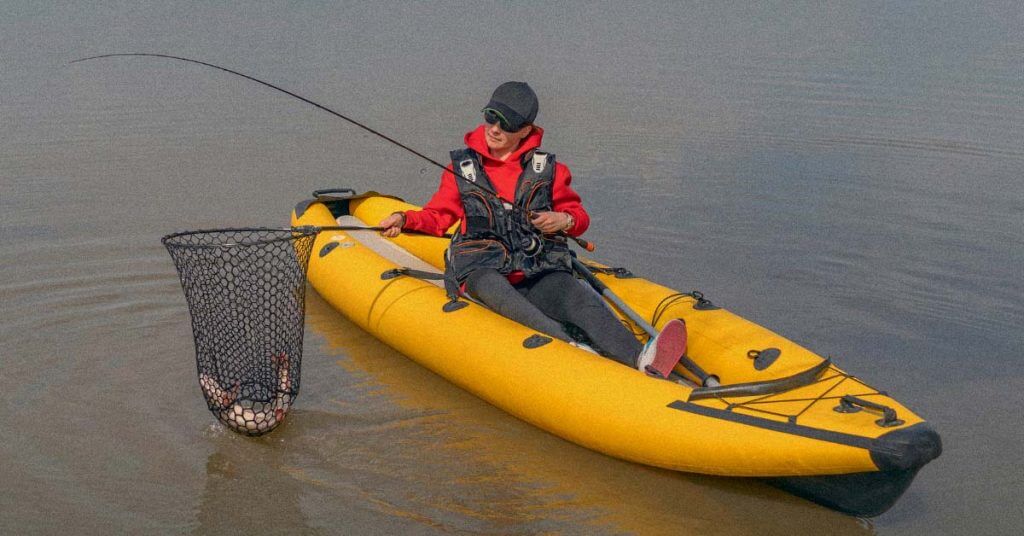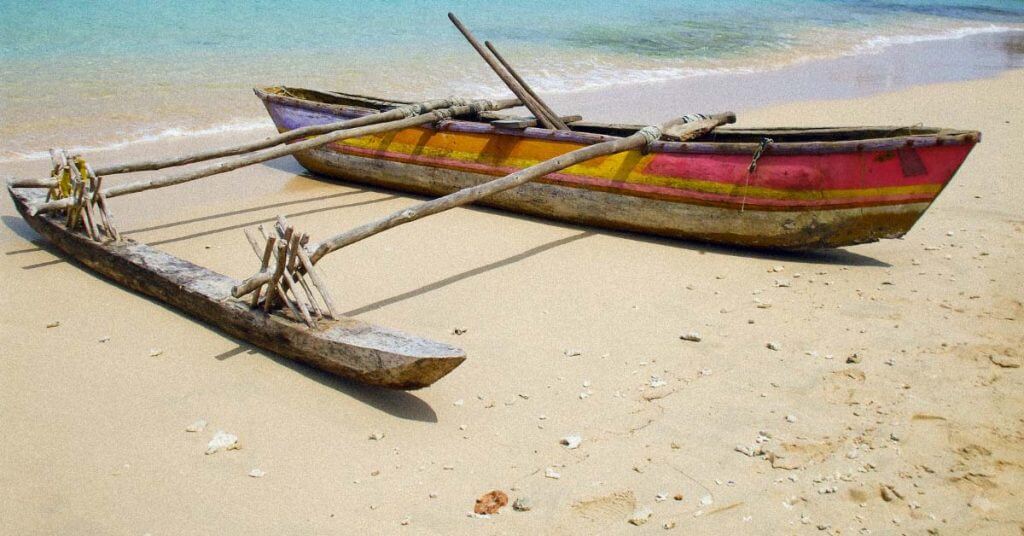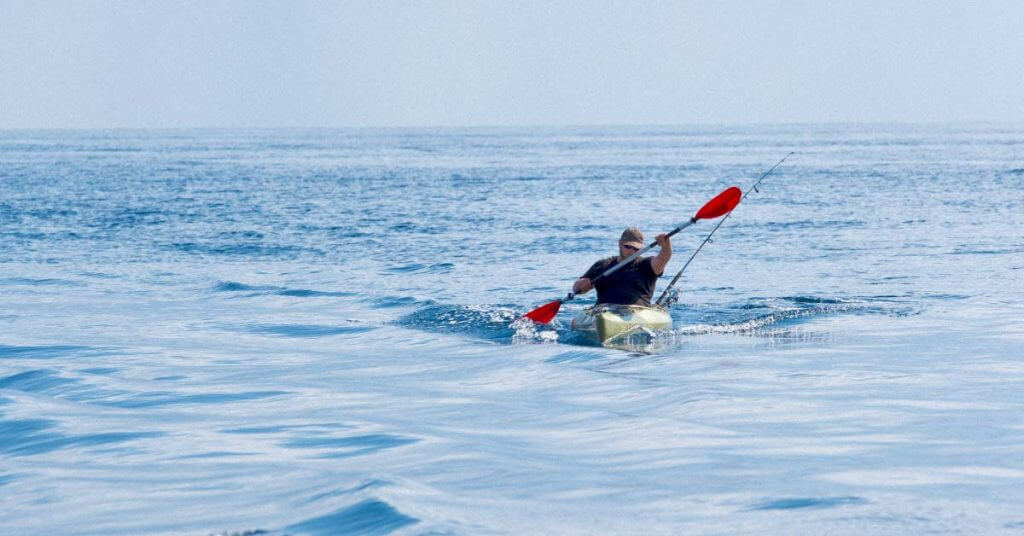The best kayak fishing tips come from a place of experience and sometimes a lack thereof. I’ve made many mistakes while kayak fishing, and I want to help you hurdle past those errors to a place of fishing bliss.
Fishing from a kayak is fun and exciting because it allows you to get in right on the action. My favorite part is that I can access areas of the water that I couldn’t reach in a larger boat.
These “secret” areas house the best fishing for kayakers and anglers alike.
It was in one of these “secret” areas I was able to land five largemouth bass that moved me up in the standings in the 2021 HafaSpot/KBF Seasonal Showdown.
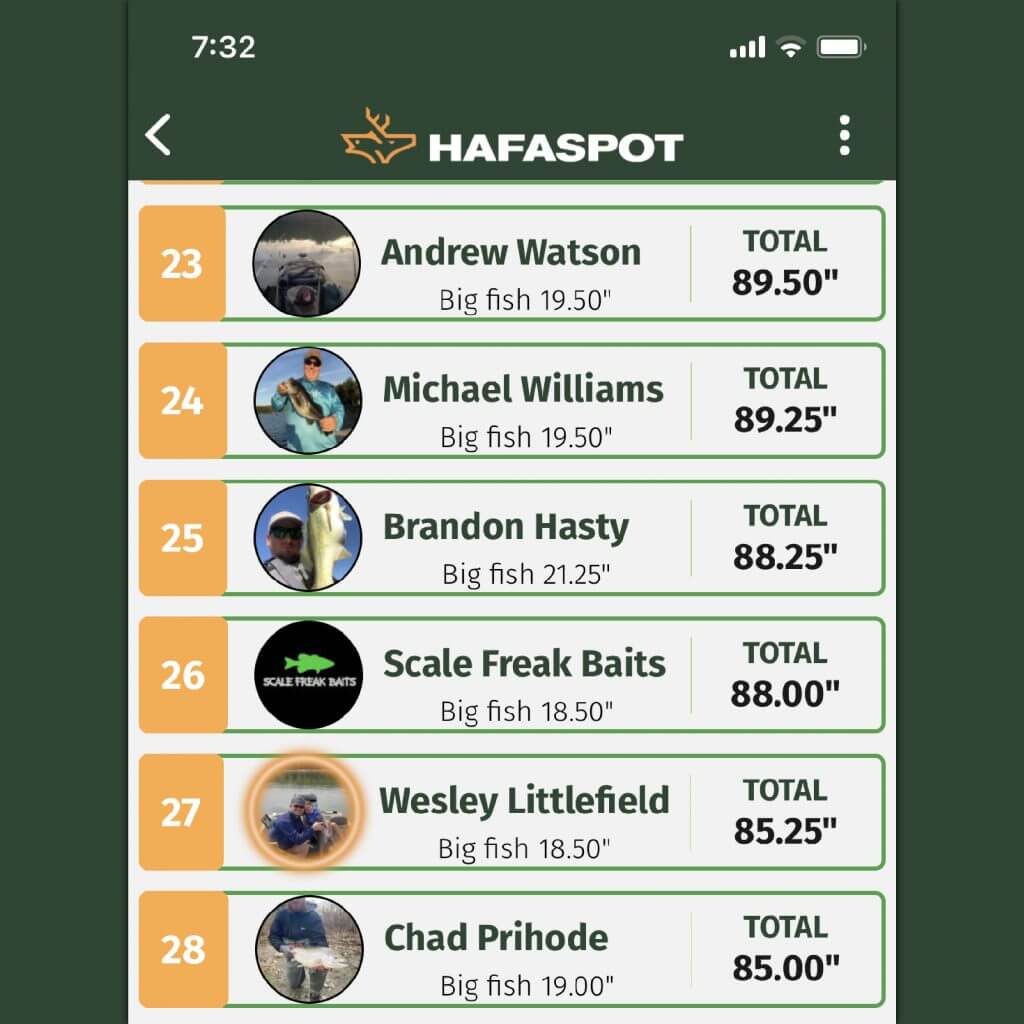
The following tips are what I wish I would have known when I was a beginner kayak angler. Learn from my mistakes and make your fishing experience an enjoyable one.
Kayak Fishing Tips For Beginners
If you take one thing away from this article please let it be to keep your setup simple. You can watch Youtube videos all day long of guys and gals who load their kayak down with way more gear than they will ever need for a day on the water.
I’ve made this mistake and it made fishing that much more difficult for me.
My fishing setup, shown in the video below, is similar to a bass boat in that I like to keep my floor as open as possible.
But before we start talking about rigging your kayak we first need to know how to choose the best kayak for your situation.
Choosing Your First Kayak
Choosing the best kayak for the job can be intimidating. The type of kayak you choose will depend on where you’re fishing, what the water looks like, and what you plan to catch.
One of the reasons a person will decide to become a kayak fisherman is because of accessibility. Kayaks allow you to reach shallow water that you can’t on a motorboat, and if you’re anything like me, you love venturing off into places that look like you’ll end up stranded on top of a stump with a nice dent (or hole!) in the bottom of your boat.
Been there, done that plenty of times.
You want to pay attention to the width, length, and weight while you’re shopping around for a new kayak.
- Width – will loosely translate into stability, which is one of the most important factors to consider. Typically, a wider kayak will be more stable than a narrower one. My kayak is 41″ wide. I have stood on the edge, intentionally trying to flip it, and could not get it to flip over. If you have decent balance, you can stand in kayaks 34″ or wider.
- Length – helps with tracking (how the kayak handles on the water while paddling). While fishing in small creeks a shorter kayak will allow you to maneuver easier. In open water, a longer kayak will handle the waves from other boats and the wind. My kayak is 12′ long. It handles the waves in open water great. While I often use it in small creeks, it is a little long. A large majority of fishing kayaks will be 10′ or longer.
- Weight – an important factor as well because you will have to take your kayak down off your vehicle (most likely), and if you are fishing alone, you’ll need something light enough to get it in and out of the water safely. Fishing kayaks can be heavy, 75-100lbs.
These features lend to your safety on and off the water. Your safety is the most important factor to consider.
Do not purchase a kayak you do not feel safe in.
There are many inflatable kayaks out there as well. While these are lightweight and easy to transport, they’re a little riskier on the water, and you won’t want to play around in the muck and the mud as much.
Not to mention, if you were to get a hook set into the kayak! I don’t know how many times I have set the hook only to have it come flying out of the water and smack the side of my kayak.
Fishing Kayaks
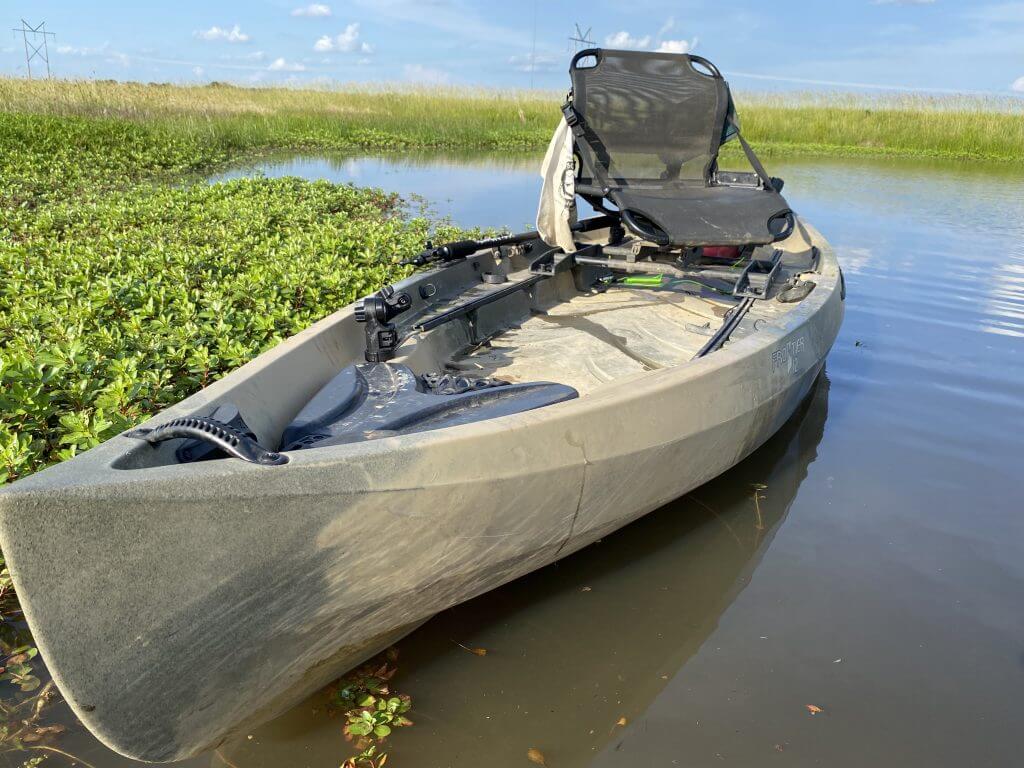
While you can fish from any yak, several companies are designing kayaks specifically for fishing. During the design process, these kayak companies keep the factors that are most important to anglers in mind.
- Comfortability – The seats are engineered to sit in comfortably for hours at a time.
- Stability – These kayaks do not easily tip. This will keep you and your hundreds of dollars worth of gear safe so you don’t have to worry. In addition, you can always buy a kayak outrigger to increase stability even more.
- Storage – Dry storage is available on certain models as well as easily accessible tackle and rod holders.
- Customizability – Every fisherman fishes a certain style, and these boats adjust to that style instead of the fisherman being forced to adjust to the kayak. Fishing kayaks offer the opportunity for unending DIY projects!
What shocks most people is the price tag that comes with fishing kayaks. They range from $1,000 up to $5,000.
While they are expensive compared to other kayaks, they are incredibly cheap when compared to other fishing boats.
Especially, a $50,000 bass boat.
And if you look hard enough, you can find a fishing kayak for less than $1000.
No matter what style of kayak you choose, I highly recommend testing it out before you buy it. Your local kayak shop should have demo days to test out multiple kayak brands and styles.
Or get in a kayak fishing Facebook group and find someone who has the kayak you want to try out. More than likely, they will be happy to meet you at the water for a test ride.
I know I’m always eager to get more people into kayaking and fishing!
YourBassGuy.com community coordinator Wes Littlefield discusses how to get started kayak fishing in the YouTube video above.
Kayak Fishing Essentials
Check your state and local boating regulations that pertain to kayaks before heading out to the water. These essentials are what I carry with me on every fishing trip.
- Kayak fishing PFD. Always wear your life jacket. Never hit the water without your personal flotation device. I don’t know how many other ways I can say it!
- Hi-visibility flag/light
- Whistle
- Paddle and paddle leash
- Nonfibrous net
- Pliers
- Compact kayak tackle box(s)
- Multiple kayak fishing rods (if your kayak has room)
- Anchor/Stake out pole
- Measuring board
- Extra rope
- Sunscreen
- Wading shoes
- First aid kit. Emergencies happen…
- Toilet paper in a ziplock baggie. Other types of emergencies happen!
Kayak Fishing Techniques
Casting while seated in a kayak is very different than casting from the shore or boat. It takes some getting used to by way of practice. I’d highly suggest checking out Chad Hoover’s tips for practicing in the video below!
As Chad said, practice casting while sitting in your kayak on the grass, and if you have a pool to practice in, even better. You need to get used to casting from something that moves with your every move. You’re not going to tip over, but those first few casts on the water will make you feel that way.
It’s also a little more difficult to get an accurate or long-distance cast from a kayak because you don’t have as much leverage as you would standing in a bass boat.
As you practice you will develop a way to cast further and more accurately.
You’re very close to the water, so you need to cast upwards slightly more than usual otherwise, your lure will die out faster and always fall short of your target.
There is a fine balance between “rainbowing” your cast and getting enough air underneath it to go the distance you want. Practicing this in your yard or in a pool will help you get it right.
Personally, I often find myself casting sidearm to avoid overhanging trees or to skip my lure under a dock. But with that being said, I highly recommend casting from ALL angles while in your kayak to get the feel for it.
Casting while paddling, peddling, or running a trolling motor is a learning curve in and of itself. There is no substitute for putting yourself in those situations.
Trying to position yourself just right so you can cast, plus fighting the wind and/or current can be frustrating until you learn how to efficiently maneuver your yak.
In general, the best way to learn is by doing.
Kayak Bass Fishing Tips
Many experienced kayak anglers chase after a number of freshwater species such as trout and crappie but by far the most popular is bass. The following are several tips specifically for bass fishing from a kayak.
Be Stealthy
Stealth is the name of the game. There is any number of things you can do to make noise and cause disturbances in the water that spook bass since you’re so close to the fish.
Be careful not to swing your lure around and hit the side of the kayak, be gentle with your paddles if you’re trying to maneuver around with your lure in the water, and don’t move too much if you’re hot on the trail of an incoming bass. Even a slight scratch on the bottom of the kayak with your shoe will make enough noise to scare them away.
This reason is why most anglers have carpets or some type of fabric in their boat. The fabric acts as a dampener for noise so you can walk around the boat even when your lure is in the water.
Traction pads are also a popular investment because they’ll not only keep you from making as much noise, but they’re a nice safety feature to prevent slipping as well.
Always Have an Anchor
Your kayak is much lighter than most (if not all) boats, so you need a way to control the motion of your kayak and keep it in the same place when you’ve found somewhere you want to fish. This issue is important for finding bass and it will help you stay safe and smart out there.
You also need to anchor so you can secure your location, and you don’t have to keep paddling while you’re trying to catch a fish. Putting the paddles in the water will only create more disturbance, which will take away from the attention you’re trying to create with your lure and scare the fish away.
I recommend going with a pole anchor like the Power-Pole Micro Anchor. These types of anchors are small and easy to operate in shallow backwater and open water. They’re a bit expensive, so it’s certainly an investment, but it will help you spend more time focusing on catching bass and less time on keeping still.
Stay Organized
A lot of the best kayaks come with plenty of easily accessible storage areas, tackle management sections, and even places to secure your fishing rod if you do need to paddle or do something while you’re fishing.
Storage and organization are often overlooked in kayak angling, and people think they can go for any old kayak, and it’ll do the trick, but that’s not true. The reason why I suggest going with a dedicated “fishing” kayak is that they come with fishing-related features to help make your experience better, easier, and more organized.
Use Electronic Assistance
One essential piece of fishing gear is a high-quality kayak fish finder. You need a fish finder or at least an electronic depth tracker not only for finding fish but for safety. Knowing the depth allows you to make sure you can maneuver yourself into the areas you want to get into and find the right areas to fish for bass.
During many times of the year bass love hanging around changes in the structure underneath the surface. This means you want to find drop-offs, ledges, brush piles, and grass lines because that’s where you stand the best chance of finding a lot of bass.
The best fish finders will not only show you graphics of fish, but they’ll offer realistic images of what everything looks like underwater. This means you’ll be able to see any vegetation, rocks, stumps, changes in structure, and of course, fish underneath your kayak.
There are numerous ways to attach sonar to your kayak. While this is an extremely handy tool it will add extra battery weight!
Pair up With the Right Lure
You can use any lure you would normally use from the bank or bass boat while fishing from a kayak. When it comes to choosing the best lure, there are a few things we always need to consider:
- Where are we fishing?
- What time of year is it?
- What time of day is it?
- What’s the weather like?
- What fish are we targeting?
- What size fish are we targeting?
Let’s start by talking about our location. We need to look at the water clarity and see if the bass will have an easy or hard time seeing our lures. If the water is murky or a heavy rainstorm passed through recently, you might want to go with something bright and reflective like a bass fishing spoon or something with a blade.
If you’re going with soft plastics, you need to choose a color that’s bright and visible even when the water is murky. Hold your lure under the water off the side of the kayak as far down as you can and see if you can still see it. If not, it’s not bright enough.
The time of year is a huge factor because it will determine where you fish, and location helps decide on the lure type. If it’s spring/summer, bass are highly active and feeding towards the surface, so you’ll want to fish topwaters such as buzzbait or weedless frogs if you’re fishing in heavy cover.
The time of day is similar to the time of year, and you’ll want to keep in mind that bass are most active in the morning and around dusk.
If you’re fishing those times, you can use the previous strategy, but if you happen to be on the water in the middle of the day, I would suggest going with something mid-range or “near-surface” like a crankbait, spinnerbait, or a jig.
Pro Tip: Use lures with more resistance, such as a crankbait, to semi-steer your kayak while fishing.
Use the Right Rod and Reel
Now that you understand a little about choosing the right lures, we need to pair them up with the best rod and reel combo. Realistically, there are no right or wrong answers here, and it depends a lot on your personal preference.
You can use whatever you would normally use but factor in the size of the fish you’re targeting and the type of lures you’re using.
If you’re going finesse on lure size after small bass and panfish, you’ll want to go with an ultralight, fast action rod, and a high gear ratio because you need to feel every nibble, but you don’t have to worry about them snapping your line like a big fish.
If you’re on the hunt for your personal best bass, you will want a rod and reel that can handle the stress a big bass will place on your setup.
Choose Your “Paddle” Wisely
Paddling is the double-edged sword of kayak fishing. It sounds like fun when you think about it until you get out there for a few hours and realize that you’re old and out of shape (sounds like me).
That’s why many people, myself included, have added a trolling motor to our fishing kayak. I still paddle often but the trolling motor gives me a little more control and speed when I need it.
Peddle kayaks have exploded in popularity because they can add the needed control and speed with less effort than paddling.
Make sure you choose a lightweight paddle that will hold up over time. I’ve always used sealed wood paddles, but they’re a bit heavier than I’d like.
Manufacturers make paddles from composite, plastic, wood, and other materials, so you have your choice. Experiment and test them out to determine which one you like the best.
If you’d like to learn more about this, take a look at my best fishing kayak paddle article which goes for more in-depth on the subject.
Kayak Fishing Tips: Summary
I hope these kayak fishing tips are useful and actionable for you. Many of us never experience the fun and excitement of simplistic fishing, and kayaking is a great way to immerse yourself in nature and gain access to areas of water that you would have otherwise avoided.
Not only does this make fishing more fun, but it can make it more successful as well! Now it’s your turn to go have an awesome fishing adventure!

